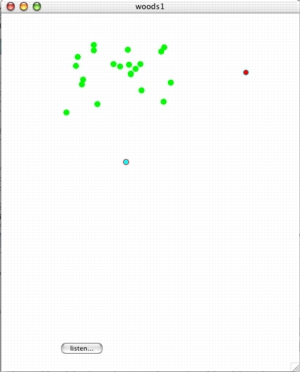week4
Links
There are a large number of web sites that discuss aspects of
acoustic space modelling and room simulation (a web search for
"room acoustic simulation" will bring yield a range of interesting
sites). Here are several just for the heck of it:
- Waveguide Mesh Modelling -- a fairly new site with some links to
other mesh-oriented modelling efforts and discussions [note:
this is like the finite-element simulation project we
described in class.]
- IRCAM Room Acoustics Team
-- IRCAM has been involved in advanced room acoustic modelling
research for several years
- a good set of links
to various other sites, including links for
Head-Related Transfer Function measurements
Francisco discussed convolution as a methodology for recreating the
acoustics of specific spaces. Several people were interested in
sites that allowed the downloading of impulse response
soundfiles/data:
We realized our convolution examples in class using Tom Erbe's marvelous
program
soundhack
Code
- woods.pat.sit
-- Max/MSP patch of woods-reflection simulation with
fixed source/listener, editable tree locations. Source
sound is from real-time input (mono output)
- woods1.tar.gz
-- the RTcmix/wxWindows woods-reflection simulation, source
sound from soundfile. Editable source and listener location
(stereo output)
- spatical1.tar.gz
-- goofy real-time spatializer, RTcmix/wxWindows positioning
of soundfile playback.
In addition to these, we also explored several extant room-simulation
programs:
- PLACE
-- Doug Scott's ray-tracing/spatial reverb matrix instrument
for stationary sources
- MOVE
-- Doug Scott's ray-tracing/spatial reverb matrix instrument
for moving sources
- SROOM
-- F. R. Moorer's original "inner room" spatial simulator for
stationary sources
- MROOM
-- F. R. Moorer's original "inner room" spatial simulator for
moving sources
- FREEVERB
-- a very high-quality, public domain reverberator
- REV
-- three older reverberation algorithms from CCRMA at Stanford
University
- REVERBIT
-- the original Schroeder comb/allpass filter reverb
moving sources
for stationary sources
Following on our discussion of outdoor space/acoustic reflection
simulation from
last week,
we investigated additional approaches to room and space simulation.
Reflections Through Trees
Simple physics gives us the ability to recreate ideal paths that sound takes
when reflected by a set of perfect point-source reflectors (virtual trees!).
All we need top do is to calculate the distance from the source of
the sound to each tree, and the distance from that tree to the listener.
This distance can be used to compute the delay time for each tree-reflected
path (assuming sound travelling at 1100 feet/second) and the degree
of amplitude attenuation due to distance (amplitude decreases at
a rate of 1/distance2).
Using this information, we showed a very simple Max/MSP patch that
allows us to place 10 virtual trees relative to a sound source and
listener. The patch accepted real-time input and recreated the delay
and amplitude pattern for a given set of trees.

The problem with this patch is that it didn't capture the 'spatial'
aspect of sound being reflected through a stand of trees. For this,
we need to compute stereo delays, one to each virtual ear of the
virtual listener. Our ears decode directionality using amplitude
cues and timing cues, so our simple model can be extended quite
easily just by computing two sound paths (one left, one right)
between the source and listener.
We showed an RTcmix/wxWindows model that did this, using a soundfile
(that happy barking Loocher dog) as source. This time we added
a feature allowing us to move the source and the listener, as
well as setting up the stand of trees randomly within a selected
area. This made it easy to explore a range of different physical
layouts and corresponding reflection patterns.

Room Simulation, Spatializing
The problem with these models is that they ignore secondary, tertiary
and additional n-ary reflections that occur between the
trees. Contemporary room and space simulation software attempts
to model these using a set of short, recirculating delay-lines
to create a 'diffuse' sound following an initial set of
reflections coming from the walls of a room. We showed existing
software that demonstrated the effectiveness of this approach,
and also discussed the notion of an "inner room" for speaker-playback
simulations (as opposed to headphone, binaural simulations).
We had described earlier in the class the concept of performance
spatializing, or diffusion that is fairly popular
in European concerts. About the closest we get to this is in THX-like
movie theaters, where the attacking spacecraft always approaches
from behind the audience. We then built a very crude stereo "spatializer"
using Doug Scott's advanced room simulation code -- we could 'move'
the soud image around by directing our mouse cursor around a modelled
listener location. It didn't really work all that well...
Convolution
Francisco ended the class with a discussion of convolution as a room
simulation technique. Convolution is a way of multiplying the
frequency and time characteristics of two signals together in such
a fashion that it sounds as if one signal was "imbedded" on the
other. By using an impulse response signal of a particular space,
we can "imbed" an arbitrary input signal (our voice, a recording of
something else, etc.) in a measured room response and make it
sound as if the input signal were inside the room. It is a very
effective technique used in many popular signal-processing
plugins (Altiverb, Waves, etc.), although it is not as flexible in
theory as a room or spatial model. You simply haven't lived a complete
audio life until you've heard your voice in a room 2 feet wide and
2000 feet long.
Finite Element Simulation
We forgot to cover this, so we're going to do it
next week. We'll also play some
more examples of convolved sound.


